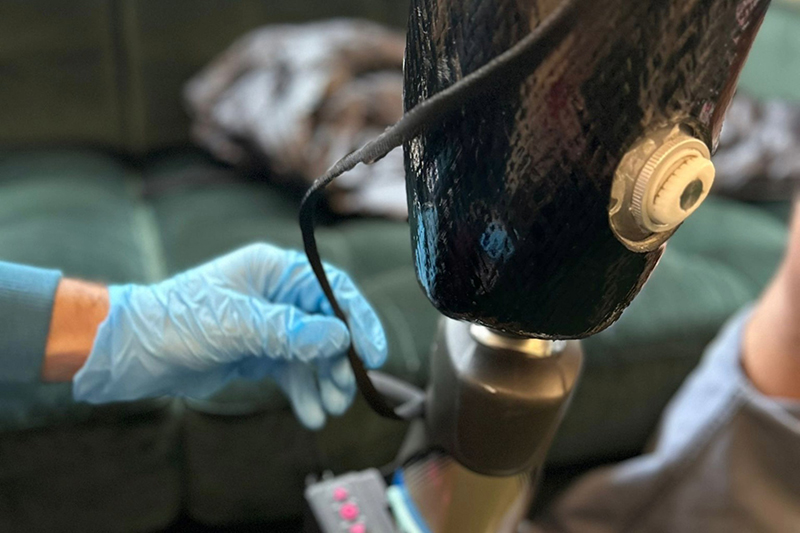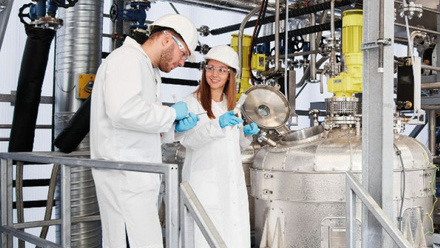Silicone elastomer brings adjustable prosthetic limbs to life
‘Roliner’ could allow amputees to change the shape, volume and stiffness of the liner that attaches a prosthetic limb’s socket to a residual leg.

Scientists at Imperial College London, UK, say the patented material has been eight years in the making.
They explore the work in a paper on Dynamically adaptive soft metamaterial for wearable human-machine interfaces in Nature Communications.
It is made from silicone elastomers with millifluidic channels created using embedded wax paper cut-outs with a nominal thickness of 250µm during fabrication.
A portable electro-pneumatic control unit adjusts pressure dynamically, while cloud-data structure stores and analyses user data and communicates with a smartphone app that collects device data and user preferences.
The embedded millifluidic channels transition from a flat stage to an inflated 3D state when pressurised, explains Dr Uğur Tanriverdi, co-founder of Unhindr Wearable Robotics, commercialising the technology.
'This adaptive change reconfigures the shape and mechanical properties of Roliner (e.g. stretchability, surface geometry and stiffness)'.
He expands, 'Tuning the fluidic pressure within this material architecture changes the material behaviour, dynamically adjusting its properties.
'Silicone layers and adhesives ensure structural integrity, while fabric coatings improve usability by reducing surface tackiness.'
Furthermore, Roliner can incorporate artificial intelligence (AI), so each liner can ‘learn’ the amputee’s personal preferences.
It does this by integrating multiple data points, such as step count, movement patterns, location, comfort preferences, device interactions and sensor readings. This information is analysed to offer personalised suggestions that adapt to the user’s needs and activities.
The material can also automatically adjust its properties according to how the human body changes in response to variables such as the time of day, weight loss or gain, and hormonal fluctuations. The inventors note an amputee’s desired fit may also change due to the type of activity.
Ultimately, users can then tweak the shape, volume and stiffness through their smartphone to adjust for fit, ensuring both short-term and long-term adjustments without interrupting the user journey. The material is worn and cared for like a regular liner, improving comfort and preventing injuries associated with poor-fitting prosthetics.
This integration also reduces friction and pressure points, improving the user experience during movement.
Guglielmo Senesi, the Imperial engineer building Roliner’s electronics and clinical data architecture, and Chief Technology Officer at Unhindr, adds, 'Currently, most prosthetists still rely on plaster casting and moulding techniques that have been used for centuries to determine what socket shape and size will give the most personalised fit. Roliner’s data-driven approach standardises the quality of prosthetic fittings.'
The liner sleeve doesn’t have any electronics, is hand washable and can be cut-to-size.
Its thickness is comparable to existing liners, with a diameter of 45mm and an average thickness of 6.63mm. This makes it compatible with existing prosthetic sockets, unlike many other adaptive approaches that require replacement.
Its instant customisation also reduces clinical dependency by providing personalised healthcare, enhancing comfort and usability. The team validated Roliner, along with accompanying hardware and software, in a set of pre-clinical human trials with six amputees from diverse backgrounds. In the pre-clinical experiments, they have determined that the control unit can last up to eight days with a battery capacity of 3,000mAh.
The research team used existing manufacturing techniques to develop the material with these unique properties.
Tanriverdi says Roliner also expands possibilities for advanced wearable devices.
'Being a metamaterial, its design opens doors to applications like advanced garments for exoskeletons and biomedical monitoring systems in space applications.'
The focus for the company now shifts to commercialisation, scaling production methods and potentially integrating sensors to monitor health metrics for enhanced functionality.
The researchers hope Roliner will be available in the UK by the end of this year.







